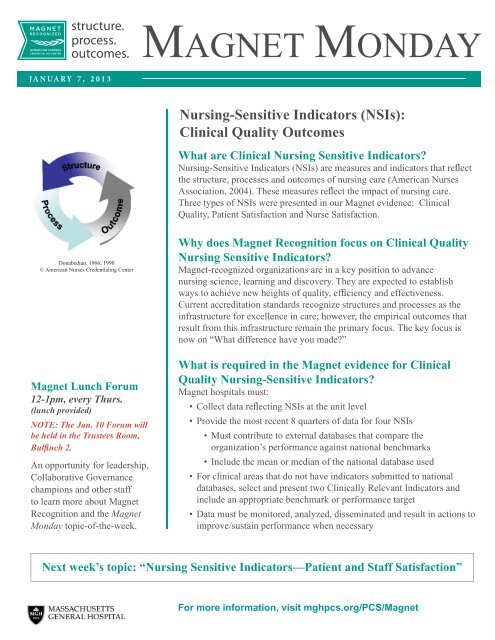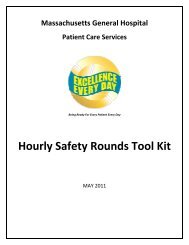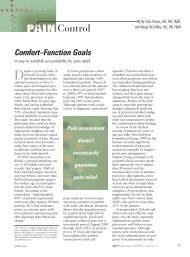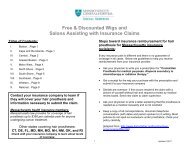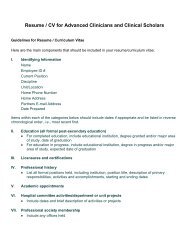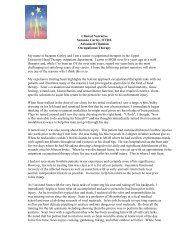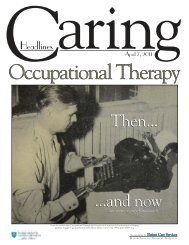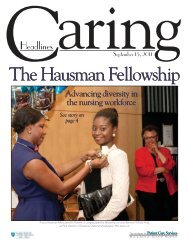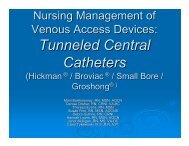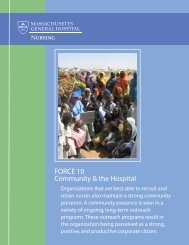Nursing-Sensitive Indicators (NSIs): Clinical Quality ... - Mghpcs.org
Nursing-Sensitive Indicators (NSIs): Clinical Quality ... - Mghpcs.org
Nursing-Sensitive Indicators (NSIs): Clinical Quality ... - Mghpcs.org
- No tags were found...
Create successful ePaper yourself
Turn your PDF publications into a flip-book with our unique Google optimized e-Paper software.
structure.process.outcomes.MAGNET MONDAYJANUARY 7, 2013<strong>Nursing</strong>-<strong>Sensitive</strong> <strong>Indicators</strong> (<strong>NSIs</strong>):<strong>Clinical</strong> <strong>Quality</strong> OutcomesWhat are <strong>Clinical</strong> <strong>Nursing</strong> <strong>Sensitive</strong> <strong>Indicators</strong>?<strong>Nursing</strong>-<strong>Sensitive</strong> <strong>Indicators</strong> (<strong>NSIs</strong>) are measures and indicators that reflectthe structure, processes and outcomes of nursing care (American NursesAssociation, 2004). These measures reflect the impact of nursing care.Three types of <strong>NSIs</strong> were presented in our Magnet evidence: <strong>Clinical</strong><strong>Quality</strong>, Patient Satisfaction and Nurse Satisfaction.Donabedian, 1966; 1990© American Nurses Credentialing CenterMagnet Lunch Forum12-1pm, every Thurs.(lunch provided)NOTE: The Jan. 10 Forum willbe held in the Trustees Room,Bulfinch 2.An opportunity for leadership,Collaborative Governancechampions and other staffto learn more about MagnetRecognition and the MagnetMonday topic-of-the-week.Why does Magnet Recognition focus on <strong>Clinical</strong> <strong>Quality</strong><strong>Nursing</strong> <strong>Sensitive</strong> <strong>Indicators</strong>?Magnet-recognized <strong>org</strong>anizations are in a key position to advancenursing science, learning and discovery. They are expected to establishways to achieve new heights of quality, efficiency and effectiveness.Current accreditation standards recognize structures and processes as theinfrastructure for excellence in care; however, the empirical outcomes thatresult from this infrastructure remain the primary focus. The key focus isnow on “What difference have you made?”What is required in the Magnet evidence for <strong>Clinical</strong><strong>Quality</strong> <strong>Nursing</strong>-<strong>Sensitive</strong> <strong>Indicators</strong>?Magnet hospitals must:• Collect data reflecting <strong>NSIs</strong> at the unit level• Provide the most recent 8 quarters of data for four <strong>NSIs</strong>• Must contribute to external databases that compare the<strong>org</strong>anization’s performance against national benchmarks• Include the mean or median of the national database used• For clinical areas that do not have indicators submitted to nationaldatabases, select and present two <strong>Clinical</strong>ly Relevant <strong>Indicators</strong> andinclude an appropriate benchmark or performance target• Data must be monitored, analyzed, disseminated and result in actions toimprove/sustain performance when necessaryNext week’s topic: “<strong>Nursing</strong> <strong>Sensitive</strong> <strong>Indicators</strong>—Patient and Staff Satisfaction”For more information, visit mghpcs.<strong>org</strong>/PCS/Magnet
structure.process.outcomes.MAGNET MONDAYJANUARY 7, 2013How are the <strong>Clinical</strong> <strong>Quality</strong> <strong>Nursing</strong>-<strong>Sensitive</strong> and <strong>Clinical</strong>lyRelevant Indicator performance evaluated by Magnetappraisers?<strong>Clinical</strong> quality <strong>NSIs</strong> and clinically relevant indicators were presented forevaluation in two sections of our Magnet evidence: Organizational Overview andExemplary Professional Practice Empirical Outcomes.Organizational Overview Section (OOD 23); Not Scored• All <strong>Clinical</strong> <strong>Quality</strong> <strong>Nursing</strong> <strong>Sensitive</strong> <strong>Indicators</strong> monitored(from Magnet list)• All <strong>Clinical</strong>ly Relevant <strong>Indicators</strong>• Evaluated for sustained performance and improvementExemplary Professional Practice Empirical Outcomes (EP #32 EO)Requirements; Scored• <strong>Clinical</strong> <strong>Quality</strong> <strong>Nursing</strong>-<strong>Sensitive</strong> <strong>Indicators</strong> (four)• The majority of the data must out-perform the mean or median, on a majorityof units, the majority of the timeWhat did the NSI data demonstrate about our performance?IndicatorNumber of UnitsOutperformingBenchmarkJuly 2010 - June 2012PercentageOutperformingBenchmarkFalls per 1000 Patient Days 17 of 31 54.84%Percentage of Patients with Physical Restraints (Limb28 of 36 77.78%and Vest)Percentage of Patients with Hospital Acquired19 of 35 54.29%Pressure UlcersCentral Line-Associated Bloodstream Infections(CLABSI) per 1000 Line Days5 of 9 55.56%Do you know………..?• What data was submitted for your clinical area?• How did your department’s performance compare to the benchmark?• What has your unit/department done to maintain or improve performance?For more information, visit mghpcs.<strong>org</strong>/PCS/Magnet
What We MeasurePressure UlcersFallsPhysical RestraintsPediatric Peripheral InfiltrationsCentral Line Blood Stream InfectionsCatheter-Associated Urinary TractInfectionsVentilator-Associated PneumoniaTime in Therapeutic RangeCompletion of INRs in 28 daysAdministration of Prophylactic Antibioticsbefore Surgical IncisionUniversal ProtocolAdministration of Prophylactic Antibioticbefore Cardiovascular Electronic DeviceImplementationDVT Prophylaxis +/- 24 hours beforeSurgeryAdministration of Prophylactic Antibioticsbefore Cesarean SectionAdministration of Appropriate DVTProphylaxis before Cesarean SectionHuman Papillomavirus VaccineInfluenza Vaccine with AsthmaDiabetes Self ManagementInformed ConsentCompletion of RN Machine Safety CheckPrior to Initiation of DialysisPre-operative Fall Risk AssessmentSuccessful First Attempts at PeripheralIntravenous InsertionsOcclusion Rates in ICC LinesProportion of Infants in 22 to 29 WeeksGestation Treated with Surfactant within 2hours of birthProportion of Infants in 22 to 29 WeeksGestation Screened for Retinopathy ofPrematurity (ROP)Managing Post-operative Care Correct TraySet-up ProtocolVascular Access Time-OutDoor to IV rt-PA in 60 MinutesDoor to CT Scan (median time)Acute Myocardial Infarction (AMI): PrimaryPCI within 90 minutes of ArrivalFor more information, visit mghpcs.<strong>org</strong>/PCS/Magnet


